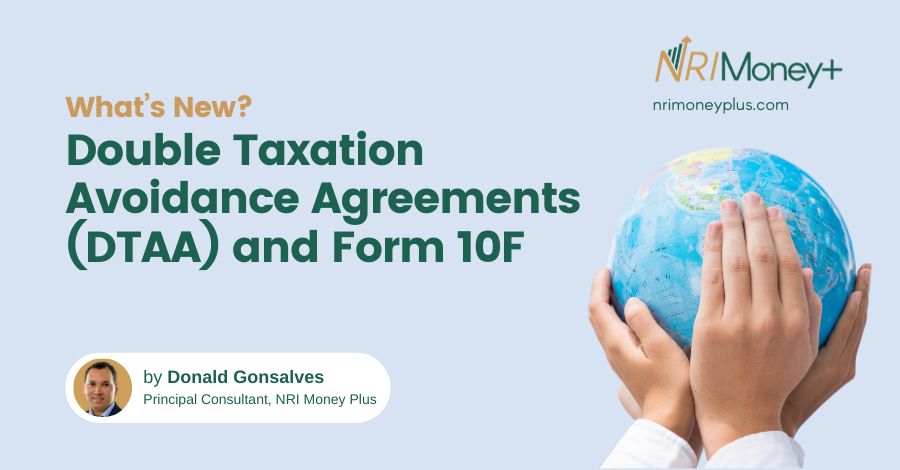Double Taxation Avoidance Agreements (DTAA) are established between two countries to prevent the taxation of the same income in both nations. In India, Section 90 of the Income Tax Act, 1961, empowers the central government to form these agreements with other countries, facilitating economic relations, trade, and investments while avoiding double taxation.
Under DTAA, income is taxed in only one of the involved countries, sparing the taxpaying NRI or Non-Resident Indian from paying taxes in both. However, specific documentation is required to claim this exemption. Section 90A(4) of the Income Tax Act mandates that non-resident taxpayers must obtain a tax residency certificate from their home country to enjoy DTAA benefits.
Now, let’s delve into the details of Form 10F and its associated requirements:
1. Form 10F Under the Income Tax Act
Any income earned or arising in India is subject to taxation in India, even for non-residents. Additionally, Tax Deducted at Source (TDS) is applicable to such income payments to Non-Resident Indians. However, in certain cases, the NRI may not be liable to pay income tax in India, thanks to DTAA agreements.
According to Section 90(4) of the Income Tax Act, non-resident taxpayers can claim DTAA benefits if they possess a Tax Residency Certificate (TRC) from their home country. To facilitate this process, Section 90(5) in conjunction with Rule 21AB of the Income Tax Rules requires taxpayers to provide specific information in Form 10F, including:
- Taxpayer’s status (individual, company, firm, etc.)
- PAN Number
- Nationality (for individuals) or Country of incorporation/registration (for others)
- Tax Identification Number in the country of residence or Unique Tax Identification Number
- Period of residential status
- Address in the country of residence
To avail of DTAA benefits, the taxpayer must submit Form 10F along with the obtained TRC to the income tax authorities. Rule 21AB stipulates that if the TRC contains the required information found in Form 10F, such as nationality, status, tax details, and address, the taxpayer need not duplicate this information in Form 10F. Nevertheless, providing complete information in Form 10F is advisable to avoid disputes.
2. Understanding the Tax Residency Certificate (TRC)
TRC is issued by Income Tax Authorities, certifying the taxpayer’s resident status in a particular country for income tax purposes. For residents seeking DTAA benefits in another country, the Tax Residency Certificate is issued in Form 10FB, confirming residency in India for the Income Tax Act’s purposes.
The application for a Tax Residency Certificate is submitted in Form 10FA, and the certificate is valid for one financial year. It includes the following information:
- Name of the person
- Status
- PAN or Aadhar Number
- Address during the period of residency
- Certification of residency in India for income tax purposes
- Certificate’s validity period
- Date of issuance
3. Procedure for Filing Form 10F
Initially, non-residents were required to manually file Form 10F with jurisdictional officers. However, electronic filing of Form 10F became mandatory through a notification dated 16th July 2022. The online filing process involves the following steps:
- Log in to the income tax portal at https://www.incometax.gov.in/iec/foportal using PAN and password.
- Select ‘Income Tax Forms’ under the e-file tab and then choose ‘File Income Tax Forms.’
- Select ‘Persons not dependent on any Source of Income (Source of Income not relevant).’
- Pick Form 10F from the list of available forms.
- Select the relevant Assessment Year (AY) and proceed.
- Enter the required details and attach a copy of the TRC.
- Sign Form 10F using a digital signature or electronic verification code according to Rule 131 of IT Rules.
4. PAN Requirement for Non-Residents Filing Form 10F
Previously, non-resident taxpayers had the option to manually file Form 10F without needing a PAN. However, since mandatory e-filing was introduced, taxpayers must obtain a PAN in India, even if they are not obligated to have one under the Income Tax Act. This requirement is due to the fact that accessing the income tax portal for filing Form 10F now requires a PAN.
To ease this transition, the Income Tax Department temporarily relaxed the mandatory e-filing requirement for non-residents without a PAN until 30th September 2023. After this date, all taxpayers, even those not required to file income tax returns in India, will need to obtain a PAN.
Closing Thoughts about DTAA and Form 10F
PAN serves as a valid identity proof in India. The mandatory requirement of obtaining a PAN in India for non-residents, even if they have no tax obligations, ensures their official record in India’s tax system.
These measures aim to streamline tax procedures and promote transparency in cross-border taxation.

Donald G. is the Principal Consultant at NRI Money+. He specialises in creating personalised financial plans for NRIs (Non-Resident Indians) and HNI (High Net-worth Individuals).



